药明康德Pd催化的偶联反应MA070818精品PPT课件
- 格式:ppt
- 大小:1.68 MB
- 文档页数:63
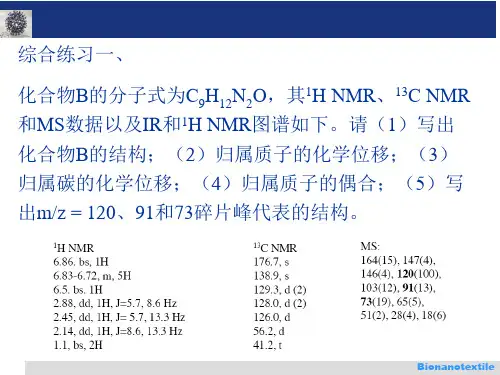



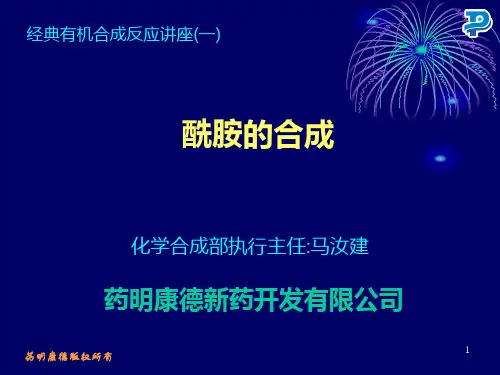

DOI:10.1002/anie.200602761Palladium-Based Catalytic Systems for the Synthesis of Conjugated Enynes by Sonogashira Reactions and Related AlkynylationsHenri Doucet*and Jean-Cyrille Hierso*AngewandteChemieKeywords:alkynes ·cross-coupling ·heterogeneous catalysis ·palladium ·sonogashira reactions8342007Wiley-VCH Verlag GmbH &Co.KGaA,WeinheimAngew.Chem.Int.Ed.2007,46,834–8711.IntroductionThe palladium-catalyzed cross-coupling between sp 2-hybridized carbon atoms (C(sp 2))aryl,heteroaryl,and vinyl halides and sp-hybridized carbon atoms of terminal acety-lenes (C(sp))pertains to the family of modern and extremely powerful synthetic methods for the synthesis of important organic intermediates.The conjugated p systems resulting from alkynylation reactions—conducted either with alkynyl-metal reagents or directly with terminal alkynes—are build-ing blocks often encountered within natural products,phar-maceutical molecules,synthetic agrochemicals,and molecular materials.The palladium/copper co-catalyzed alkynylation of aryl and vinyl halides is probably the most widely employed methodology to yield enynes;a simpler version of the reaction requires exclusively a palladium catalyst (widely known as copper-free alkynylation).Collectively,the seminal works by Stephens and Castro (1963),[1]Dieck and Heck (1975),[2]Cassar (1975),[3]and Sonogashira,Tohda,and Hagihara (1975)[4]have initiated an outstanding number of studies in the fields of organic chemistry,organometallic chemistry and catalysis,total syn-thesis,and material science.[5–8]The original reactions and their experimental conditions,as disclosed by the pioneering authors (Scheme 1),reveal both a straightforward applicabil-ity and a very large substrate range,which is probably at the origin of their success.Sonogashira and related alkynylation reactions have been covered in the last few years by several relevant reviews,inresearch.[5–19]Table 1lists these and other pertinent review articles related to the palladium-catalyzed synthesis of con-jugated enynes and the various applications of these reactions.In 2006Tykwinski and Shi Shun reviewed the synthetic efforts directed towards the synthesis of polyyne natural products,together with a highlight of the natural sources and biological relevance of some selected examples.[9]The impor-tant role of palladium-catalyzed alkynylations in total syn-thesis has been covered in a recent review by Nicolaou et al.[7]The performances of the current palladium catalysts with the highest turnover numbers (TONs)or turnover frequen-cies (TOFs)in homogeneous phase cross-coupling,including Sonogashira and related reactions,were critically examined by Farina in 2003;[10]Fu and Littke had previously covered the palladium-catalytic systems able to activate the relatively inert chloride substrates.[11]Several reviews have surveyed the results obtained for alkynylation reactions carried out in the presence of carbene ligands [12–15]or palladacyle com-plexes.[13,16]Conceptual advances by Tykwinski,[17]cross-coupling in water by GenÞt and Savignac,[18]and advances on mechanistic aspects by Jutand [19]have also been covered.In light of these recent reviews it appears that a critical discussion specifically devoted to all the different classes of catalytic systems proposed to date for homogenous andC onjugated alkynes are recurring building blocks in natural products,a wide range of industrial intermediates,pharmaceuticals and agro-chemicals,and molecular materials for optics and electronics.The palladium-catalyzed cross-coupling between sp 2-hybridized carbon atoms of aryl,heteroaryl,and vinyl halides with sp-hybridized carbon atoms of terminal acetylenes is one of the most important develop-ments in the field of alkyne chemistry over the past 50years.The seminal work of the 1970s has initiated an intense search for more general and reliable reaction conditions.The interest in the catalytic activation of demanding substrates,the need to minimize theconsumption of depletive resources,and the search for easy access to an increased variety of functionalized enynes has led to the current generations of high-turnover catalysts.This Review gives an overview of the highly efficient palladium catalyst systems for the direct alky-nylation of C(sp 2)halides with terminal alkynes,both in homogeneous and heterogeneous phases.From the Contents1.Introduction 8352.Sonogashira–Heck Alkynylations in the Homogeneous Phase 8363.Recyclable Systems for Sonogashira–Heck Alkynylations8504.Miscellaneous and Connected Studies8615.Summary and Outlook868[*]Dr.H.DoucetInstitut Sciences Chimiques de Rennes UMR 6226CNRS-UniversitØde Rennes “Catalyse et Organometalliques”Campus de Beaulieu,35042Rennes (France)Fax:(+33)2-23-23-69-39E-mail:henri.doucet@univ-rennes1.frDr.J.-C.HiersoLaboratoire de Synth se et Electrosynth se OrganomØtalliques associØau CNRS (UMR 5188)FacultØdes sciences Mirande UniversitØde Bourgogne9avenue Alain Savary,21078Dijon (France)Fax:(+33)3-8039-3682E-mail:jean-cyrille.hierso@u-bourgogne.frHomepage:http://www.u-bourgogne.fr/LSEO/Equipes/PagesEquipes/EquipeMEUNIER/JeanCyrHIERSO.html835Angew.Chem.Int.Ed.2007,46,834–871 2007Wiley-VCH Verlag GmbH &Co.KGaA,Weinheimheterogeneous Sonogashira–Heckalkynylation reactions would be timely and useful.Herein we compare the highly efficient palladium catalyst systems reported for the direct alkynylation of C(sp 2)halides with terminal alkynes in the presence (Sonogashira—Tohda–Hagihara reaction)and without (Dieck–Heck–Cassar alky-nylation)a copper co-catalyst.The advantages of the reactions being carried out in a homogeneous phase are covered in the first part,notably:1)high turnover numbers,2)the coupling of the widely available and low-cost aryl chlorides,3)milder reaction conditions and the minimization of the consumption of depletive resources.The second part isdevoted to the recyclable catalytic systems both in homoge-neous and heterogeneous phases:1)biphasic (and/or ther-momorphic)systems,2)colloidal and solid-supported cata-lysts,and 3)systems using unusual solvents,such as ionic liquids.The last part is a discussion on other closely related research in this field,especially:1)new activation processes (microwaves and sonication),2)catalytic systems using other metals and the so-called “metal-free”systems,and 3)recently disclosed unusual coupling partners.The remaining chal-lenges in the field as well as the desirable developments are outlined in the conclusion.In this Review,the literature cut-off on this very productive topic in organic chemistry and catalysis was the beginning of 2006.2.Sonogashira–Heck Alkynylations in the Homogeneous PhaseIn the last three decades a large number of palladium–ligand complexes (and even ligand-free catalytic systems)have been tested on homogeneous-phase Sonogashira–Heck–Cassar reactions.These studies have shown that virtually any palladium source is capable of reaching high TONs for facile reactions—such as the coupling of aryl iodides with phenyl-acetylene—provided appropriate reaction conditions are found.On the other hand,with less-reactive substrates—such as electron-rich or sterically congested aryl bromides,aryl chlorides,propargyl alcohols,or propargylamines—much lower TONs are generally obtained,and the ligands have a large influence on the outcome of the reactions.Therefore,the systematic study of TONs in palladium-catalyzed C ÀC bond-formation processes is an important area of research for future industrial applications.For this reason the focus herein is placed upon the TONs of the reactions rather than on the yields,which are generally high.The factors that affect the rates of the Sonogashira reaction are not completely understood,however,the steric and electronic properties of the ligands and catalysts are determining parameters.In the following,we discuss succes-sively the results of studies carried out on systems incorpo-rating either monophosphanes,carbenes,and di-,tri-,and tetradentate ligands,as well as palladacycles;herein emphasis is placed upon the alkynylation reactions which employed vinyl and aryl bromides or chloride substrates.Henri Doucet was born in Paris in 1967.He received his PhD in chemistry with Prof.P.H.Dixneuf and Dr.C.Bruneau at Rennes University.After postdoctoral positions at Oxford University (J.M.Brown)andNagoya University (R.Noyori),he moved to the University of Marseille as a CNRS researcher.His research interests include organic synthesis by metal-catalyzed process-es and ligand synthesis.At the end of 2006he joined Rennes University.Jean-Cyrille Hierso was born in Toulouse in 1971.He studied physical chemistry at the UniversitØP.Sabatier,where he worked on Pd nanochemistry (MS 1994,Dr.B.Chau-dret,LCC-CNRS)and on CVD for heteroge-neous catalysis (PhD 1997,Prof.P.Kalck).After postdoctoral research on scorpionate organometallic complexes (Prof.M.Etienne,LCC)and paints chemistry (Prof.J.Reedijk,Netherlands),in 2001he was appointed Maître de ConfØrences in Dijon.In 2006he was awarded his Habilitation on the syn-thesis of ferrocenyl polyphosphanes and their application in homogeneous catalysis.Scheme 1.Original conditions reported in pioneering works on alkynylation reactions of C(sp 2)halides.2007Wiley-VCH Verlag GmbH &Co.KGaA,Weinheim Angew.Chem.Int.Ed.2007,46,834–8712.1.High-Turnover Palladium–Ligand Catalyst Systems2.1.1.Palladium–Monophosphane SystemsThe Sonogashira–Heck coupling was originally carried out using amines as solvents.Thorand and Krause found that good yields were obtained when this reaction was carried out using2mol%[PdCl2(PPh3)2],4mol%CuI,and1.5equiv-alents of triethylamine in THF(Scheme2).For example,4-bromobenzaldehyde or4-bromoacetophenone gave the expected products with yields of99%and92%,respectively, when trimethylsilylacetylene was used.Moreover,these reactions were performed at room temperature.[20]Two years later,Fu,Buchwald,and co-workers deter-mined that[PdCl2(PhCN)2]/P(t Bu)3serves as an efficient and a versatile catalyst for a wide range of Sonogashira reactions of electron-poor or electron-rich aryl bromides at room temperature(Scheme3):4-bromoanisole couples with high efficiency,even the very electron-rich4-bromo-N,N-dimethylaniline reacts cleanly at room temperature,and Sonogashira couplings of sterically hindered aryl bromides can be achieved at room temperature.This study provided evidence of the usefulness of bulky,electron-rich phosphanes in palladium-catalyzed Sonogashira reactions.[21]The efficiency of the[Pd2(dba)3]/P t Bu3system in the absence of a copper co-catalyst was reported concomitantly by Böhm and Herrmann(Scheme4).[22]This system promotes the alkynylation of electron-rich,electron-poor,and sterically congested aryl bromides equally at room temperature,with-out the need for a CuI co-catalyst.This catalyst is highly active—only0.5mol%palladium and ligand are required. Both Et3N and THF can be employed as the solvent;Et3N plays an additional role of an organic base.The practical utility of trialkylphosphanes such as P t Bu3 can be compromised by their sensitivity to oxidation,which can render them difficult to handle.To address this problem, Netherton and Fu examined the conversion of air-sensitive trialkylphosphanes into storable,air-stable phosphonium salts by protonation of the phosphorus atom(Scheme5).The authors demonstrated that these robust salts can serve as direct alternatives to the corresponding phosphanes:a simple deprotonation by a Brønsted base under the reaction conditions releases the trialkylphosphane.[23]Table1:Review articles relating to the synthesis and application of enynes and polyynes,as well as to the catalytic systems developed for the alkynylation of halides(published after1999).Title Authors Ref. Synthesis of Naturally Occurring Polyynes R.R.Tykwinski,A.L.K.Shi Shun[9] Palladium-Catalyzed Cross-Coupling Reactions in Total Synthesis K.C.Nicolaou,P.G.Bulger,D.Sarlah[7] High-Turnover Palladium Catalysts in Cross-Coupling and Heck Chemistry:A Critical Overview V.Farina[10] Recent homogeneous catalytic applications of chelate and pincer N-heterocyclic carbenes E.Peris,R.-H.Crabtree[12] Dual role of nucleophiles in palladium-catalyzed Heck,Stille,and Sonogashira reactions A.Jutand[19] Palladium-Catalyzed Alkynylation E.-I.Negishi,L.Anastasia[6] Evolution in the Palladium-Catalyzed Cross-Coupling of sp-and sp2-Hybridized Carbon Atoms R.R.Tykwinski[17]Phospha-palladacycles and N-heterocyclic carbenes palladium complexes: efficient catalysts for CÀC coupling reactions W.A.Herrmann,K.Öfele,D.von Preysing,S.K.Schneider[13]N-Heterocyclic Carbenes:A New Concept in Organometallic Catalysis W.A.Herrmann[14] Palladium-Catalyzed Coupling Reactions of Aryl Chlorides A.F.Littke,G.C.Fu[11] Catalytic cross-coupling reactions mediated by palladium/nucleophilic carbene systems S.Nolan et al.[15] Development of Pd/Cu-catalyzed cross-coupling of terminal acetylenes with sp2carbon halides K.Sonogashira[5] Poly(arylethynylene)s:Syntheses,Properties,Structures,and Applications U.H.F.Bunz[8] Application of palladacycles in Heck-type reactions W.A.Herrmann,V.P.W.Böhm,C.-P.Reisinger[16] Recent developments of palladium(0)catalyzed reactions in aqueous medium J.-P.GenÞt,M.Savignac[18]Scheme2.Alkynylations of aryl bromides in THF.Scheme3.Sonogashira coupling of aryl bromides using a Pd/P t Bu3system.Scheme4.Heck coupling(copper-free)of aryl bromides using aPd/P t Bu3system.dba=trans,trans-dibenzylideneacetone.837Angew.Chem.Int.Ed.2007,46,834–871 2007Wiley-VCH Verlag GmbH&Co.KGaA,Weinheim Following the reports by Fu,Buchwald,and Herrmann (Schemes 3and 4)Soheili et al.developed a copper-free alkynylation procedure for aryl bromides with P t Bu 3at room temperature (Scheme 6).With acetonitrile as the solvent and1,4-diazabicyclo[2.2.2]octane (DABCO)as the base,the reaction of activated and electron-rich aryl bromides with aromatic and aliphatic acetylenes proceeded in good yields.A lower conversion was obtained using 4-chloroacetophe-none.[24]The efficiency of bulky,electron-rich phosphane ligands was also developed by Köllhofer and Plenio.They obtained high TONs for the alkynylation of a wide variety of aryl bromides at higher temperatures than those employed before;Na 2[PdCl 4]/P t Bu 3was used as the catalyst while HN i Pr 2was used as the solvent and the base (Scheme 7).For example,a TON of 18600was obtained for the reaction of the deactivated aryl bromide N ,N -dimethyl-4-bromoaniline with phenylacetylene at 808C.[25]By using this catalytic system,the sterically congested 1-bromo-2,6-dimethylbenzene reacted with phenylacetylene to give the expected product with a TON of 16800.They also explored the potential of (1-Ad)2PBn (1-Ad =1-adamantyl)as the ligand for this coupling instead of P t Bu 3.The coupling of various aryl bromides with phenylacetylene at catalyst loadings as low as 0.005mol %occurred in excellent yields;P t Bu 3was found to be the superior ligand for most of the substrate combinations.These two sterically hindered and electron-rich phos-phane ligands were also found to be efficient for the coupling of aryl chlorides (Scheme 8).A variety of electron-poor,electron-rich,and sterically congested aryl chlorides were successfully alkynylated in good yields and TONs using 2mol %of the catalyst.The choice of the base was decisive for the success of this reaction.While alkynes and aryl bromides couple efficiently in the presence of HN i Pr 2,reactions with aryl chlorides were troublesome.The best solvents were toluene,xylene,and DMSO,and the best base Na 2CO 3.[26]The recycling possibilities using modified ligands of this kind has also been examined (see Section 3.1.1).[27–31]Probably the most impressive results for the activation of aryl have been reported by Gelman and Buchwald using dicyclohexyl(2’,4’,6’-triisopropylbiphenyl-2-yl)phos-phane as the ligand.They have developed a general protocol for the coupling of aryl chlorides and alkynes using a low catalyst loading in the presence of this sterically congested electron-rich ligand (Scheme 9).This method requires only 0.1mol %catalyst,moderate temperatures (70–958C),and tolerates electron-rich,electron-poor,and sterically con-gested aryl chlorides.They have also observed that the addition of CuI as a co-catalyst can inhibit the coupling reaction or lead to a decrease in the yield.A good functional group compatibility and a broad range of compatible alkynes characterize this new catalytic system.[32]For example,the reaction of 2-chloroanisole with phenylacetylene gave the coupling product with a TON of 950and in 95%yield.A sulfonated version of this ligand for a Sonogashira reaction in water has also been described (see Section 2.3).[33]A few other bulky and electron-rich phosphane ligands have been prepared and tested in the Sonogashira reaction.A palladium complex of 1,3,5,7-tetramethyl-2,4,8-trioxa-6-phenyl-6-phosphaadamantane has been shown to beanScheme 5.Air-stable phosphonium salts used in Sonogashira alkynyl-ations of arylbromides.Scheme 6.Heck alkynylation of aryl bromides and chlorides using a Pd/P t Bu 3system.Scheme 7.Sonogashira coupling of aryl bromides using Pd/P t Bu 3and Pd/(1-Ad)2PBnsystems.Scheme 8.Sonogashira alkynylation of aryl chlorides using Pd/P t Bu 3and Pd/(1-Ad)2PBn systems.2007Wiley-VCH Verlag GmbH &Co.KGaA,WeinheimAngew.Chem.Int.Ed.2007,46,834–871effective catalyst for the alkynylation of aryl bromides, including electron-rich or sterically congested ones(Scheme10).[34]Capretta and co-workers have also demonstrated that the phosphorinane family of trialkylphosphane ligands can be used in the Sonogashira reaction of aryl bromides (Scheme11).[35]The reactions were performed at room temperature in dioxane with HN(i Pr)2as the base and CuI as the co-catalyst.Wolf and Lerebours developed a combination of a palladium source and a phosphinous acid as the catalyst for a Sonogashira reaction that proceeds in water and in air without the need for an organic cosolvent(Scheme12,see also Section2.3).Disubstituted alkynes have been prepared in up to91%yield by the coupling of various aryl halides in the presence of tetrabutylammonium bromide and pyrroli-dine or NaOH using10mol%catalyst.[36]Zhang and co-workers have developed a copper-and amine-free Sonogashira reaction using readily prepared,air-stable aminophosphane ligands.The mild reaction conditions and the utilization of an inorganic base are the most attractive features of this reaction(Scheme13).The use of electron-rich and bulky ligands might make both the oxidative addition and the reductive elimination steps easier.However,these ligands have not yet been tested in the activation of aryl chlorides.[37] Martensson and co-workers have attempted to optimize the copper-free alkynylation reaction through careful choice of the solvent and base.Several reactions were conducted using4-trifluoromethyliodobenzene to examine the depend-ence of the alkynylation on the solvent,base,and ligand(such as AsPh3or P(OEt)3,Scheme14;see also Section4.3).[38][PdCl2(PCy3)2]showed high catalytic activity in the cross-coupling of aryl chlorides with a variety of terminal alkynes in DMSO at100–1208C under copper-free conditions and with Cs2CO3as the base(Scheme15).The advantages of this copper-free procedure include the availability and ease of handling of the catalyst,and a high catalytic activity for bothScheme9.Heck alkynylation(copper-free)of aryl chlorides using a Pd/PCy2(triisopropylbiphenylyl)system.Scheme10.Heck alkynylation of aryl bromides using a Pd/phospha-adamantane system.Scheme11.Sonogashira coupling of aryl bromides using a Pd/phos-phorinane system.Scheme12.Alkynylation in water employing a palladium–phosphinousacid complex as catalyst.Scheme13.Palladium/aminophosphane-catalyzed alkynylation of aryl bromides.Scheme14.Coupling of an aryl iodide using Pd/AsPh3and Pd/P(OEt)3 systems.839Angew.Chem.Int.Ed.2007,46,834–871 2007Wiley-VCH Verlag GmbH&Co.KGaA,Weinheim electron-poor and electron-rich aryl chlorides.[39]A variety of functional groups including alcohols,esters,and ketones were tolerated under these conditions.Of the relevant useful procedures,a low temperature (À208C)Sonogashira reaction of aryl iodides has also been described in which tris(2,4,6-trimethylphenyl)phosphane was used as the ligand.[40]Catalytic protocols involving a combination of a palla-dium source and monophosphane ligands emerged as very powerful systems in the Sonogashira–Heck–Cassar alkynyl-ation reactions of demanding aryl bromide and chlorides.Some of the ligands in this category,especially the sterically congested and electron-rich P t Bu 3,(1-Ad)2PBn,dicyclo-hexyl(2’,4’,6’-triisopropylbiphenyl-2-yl)phosphane,and PCy 3have led to reactions with impressive TONs,even with deactivated aryl bromides or aryl chlorides.These palladium catalysts will likely play a leading role in the development of Sonogashira–Heck alkynylation reactions in the coming years;particularly if properties such as air-and moisture-insensitivity are developed,they could replace traditional systems with PPh 3ligands.2.1.2.Systems Incorporating CarbenesCarbene ligands have also been employed for homoge-neous-phase Sonogashira–Heck reactions (Schemes 16-18).[41–48]In all cases the alkynylation products were obtained,however,generally with low TON values.The highest TON of 540was reported by McGuiness and Cavell using a carbene–pyridine ligand for the coupling of 4-bromoacetophenone with phenylacetylene (complex A in Scheme 16).[41]Bulky phenanthracenyl-substituted imidazolium-derived carbene ligands have been investigated for the copper-free alkynylation of aryl bromides and iodides (Scheme 17).A remarkable dependence on the size of the ligand was found.[44]Palladium complexes of acyclic diaminocarbenes ligands were also found to catalyze the alkynylation of aryl bromides such as 2-bromotoluene or 2-bromoanisole in high yields (Scheme 18).[45]A palladium/imidazolium chloride system has been used to mediate the coupling reaction of aryl halides with alkynylsilanes.The combination of 3mol %Pd(OAc)2and 6mol %imidazolium chloride in the presence of Cs 2CO 3as the base proved to be an efficient system for the coupling of para -and ortho -substituted aryl bromides with alkynylsilanes in high yields and with TONs of 14to 33(Scheme 19).[46]It is noteworthy that the coupling of primary and secondary alkyl bromides with terminal alkynes using palla-dium–carbene complexes as catalysts has also recently been described (see Section 4.3).[47,48]Scheme 15.Copper-free alkynylation of aryl chlorides using the complex [PdCl 2(PCy 3)2].Cy =cyclohexyl.Scheme 16.Alkynylation reactions of 4-bromoacetophenone using Pd/carbenesystems.Scheme 17.Phenanthracenylimidazolium-derived carbene ligands for the Heck alkynylation of arylbromides.Scheme 18.Heck alkynylation of ortho -substituted bromoarenes with a Pd/diaminocarbene acyclicligand.Scheme 19.A palladium/imidazolium chloride system for the coupling of aryl bromides and alkynylsilanes.2007Wiley-VCH Verlag GmbH &Co.KGaA,WeinheimAngew.Chem.Int.Ed.2007,46,834–871To date,carbene ligands do not appear to be highly efficient catalysts for the coupling of aryl chlorides.In addition,more mechanistic studies are needed to reach a better understanding of the only moderate efficiency of these catalytic systems for aryl alkynylation reactions.2.1.3.Chelating Diphosphanes,Diamines,and P,N LigandsDidentate ligands such as diphosphanes or diamines are also efficient at catalyzing Sonogashira–Heck alkynylation reactions.A polymer-supported copper-free system with a bispyrimidine ligand resulted in the efficient alkynylation of aryl iodides with high TONs(Scheme20).The use of the less reactive bromobenzene gave a satisfactory yield of up to 85%,even with Pd amounts as low as0.006mol%.The reaction of chlorobenzene can be accelerated effectively by the addition of n Bu4NBr to the reaction mixture.Under these conditions the TON was similar to those obtained with iodo-or bromobenzene.[49]A di(pyridin-2-ylmethyl)amine-derived palladium chlo-ride complex is also an efficient catalyst for the coupling of aryl iodides or bromides with alkynes(Scheme21,see also Section2.3).With this catalyst,the alkynylation can be performed under copper-free conditions in N-methylpyrroli-dine(NMP),with TONs up to200000and TOFs up to67000 for aryl iodides,and TONs up to900for aryl bromides.[50,51] The coupling of2-bromothiophene with phenylacetylene in the presence of0.1mol%catalyst led to the product in90% yield.This ligand was also anchored to a polymer for heterogeneous catalysis studies(see Section3.2.2).[51,52]The efficiency of bulky electron-rich diphosphane ligands for Sonogashira reactions with iodobenzene,bromobenzene, or activated aryl chlorides has been investigated by Astruc and co-workers(Scheme22).A TON of100was obtained for the reaction of bromobenzene with phenylacetylene.How-ever,these catalysts gave low TONs of0–15and yields of0–30%with aryl chlorides.A bis(tert-butylphosphane)was generally found to be more efficient than a bis(cyclohexyl-phosphane)ligand.[53]The efficiency of a dendrimer deriva-tive of this catalyst and a resin-supported bis(diphenylphos-phanylmethyl)aminopolystyrene complex have also been tested(see Section3.1.1).[54,55]Among the ligands used for Sonogashira–Heck alkynyl-ations,bulky phosphanes with poor s-donating ability have attracted much less attention.Their efficiency is a pleasant surprise since poor s-donor ligands would not be expected to facilitate the oxidative addition step,but rather would be assumed to be powerful inhibitors.The didentate ligand1,1’-bis[di(5-methyl-2-furyl)phosphanyl]ferrocene catalyzed the arylation of phenylacetylene efficiently(Scheme23).4-Bro-moacetophenone and4-bromoanisole were employed as the activated and deactivated substrates,respectively.The reac-tion of4-bromoacetophenone in the presence of10À4mol% catalyst gave a TON of920000,which is among the highest reported TONs for aryl bromides.4-Bromoanisole was also quantitatively converted,but with a lower TON of1000.[56] As the authors noted,a decisive advantage of the ferrocenylphosphane ligands such as1,1’-bis[di(5-methyl-2-furyl)phosphanyl]ferrocene is their robustness towards air,Scheme20.Coupling of aryl halides to phenylacetylene using a supported palladium–bispyrimidine complex.Scheme21.Alkynylation of aryl halides using a palladium–bispyridine complex.Scheme22.Alkynylations of aryl halides using palladium and anelectron-rich aminobisphosphane.Scheme23.A Pd/[bis(furyl)phosphanyl]ferrocene system for thealkynylation of aryl bromides at low concentration.841Angew.Chem.Int.Ed.2007,46,834–871 2007Wiley-VCH Verlag GmbH&Co.KGaA,Weinheim moisture (no phosphorus oxidation),and elevated reaction temperatures,which allows them to be used in substantially lower concentration.The palladium(II)complex of a ferrocene-based phosphinimine-phosphane ligand was also applied to the amine-and copper-free Sonogashira coupling of aryl iodides and aryl bromides with terminal alkynes by using one equivalent of tetrabutylammonium acetate as an activator (Scheme 24).The corresponding disubstituted alkynes were obtained in high yields and good TONs by using 0.1mol %of the Pd catalyst.[57]The combination of an iminophosphane ligand and Pd-(OAc)2was found to be more effective than a Pd(OAc)2/PPh 3complex for the coupling of some aryl bromides with alkynes (Scheme 25).[58]The efficiency of a Pd(OAc)2/pyrimidine catalyst has also been evaluated (Scheme 26).This system gave satisfactory results in terms of yields of product,however,low TONs were reported.[59]A dinuclear palladium–tetraphenyl oxalic amidinate com-plex has been used as a precatalyst in the copper-free Sonogashira reaction of 4-bromoacetophenone with phenyl-acetylene,and gave moderate TONs (Scheme 27).[60]Yoshifuji and co-workers have reported the use of didentate P ,P [61]and P ,S ligands [62]with 1,3-diphosphapropene skeletons for the coupling of iodobenzene with phenylacety-lene using 2.5mol %catalyst.The P ,P ligand was inactive for the coupling of bromobenzene.Several didentate ligands provided efficient catalytic systems for the alkynylation of aryl substrates.Three of them led to very good TONs:22300(bispyrimidine ligand,Scheme 20),200000(bipyridine ligand,Scheme 21),and 71000(bis-tert -butylphosphane ligand,Scheme 22)in the coupling of simple aryl iodide substrates.Some were even efficient at activating more demanding aryl bromides:the bispyrimidine and bipyridine ligands (Schemes 20and 21)allow the coupling of aryl bromides (TONs of 15500and 700,respectively),while the ferrocene-based didentate ligands (Schemes 23and 24)gave the arylated alkynes in fairly good to remarkably high TONs (920000and 990,respectively).Conversely,most of these ligands were found to be less efficient in the activation of aryl chlorides.2.1.4.Tri-and Tetradentate LigandsOnly a few multidentate ligands (tri-,tetradentate,or more)have been tested for Sonogashira–Heck alkynylations.This is all the more surprising since,most of the time,a threefold or more excess of the monodentate ligands are used under conventional conditions.Thus,multidentate ligands might be of great interest in the future development of catalytic alkynylations.The potential of a tridentate C,N,C-dicarbene pincer ligand has been evaluated in the reaction of iodobenzene and 4-bromoacetophenone with phenylacetylene (Scheme 28).Iodobenzene and phenylacetylene can be coupled in 92%yield in pyrrolidine using 1mol %of this catalyst and CuI as a promoter.On the other hand,a 10%yield was obtained after 19h from 4-bromoacetophenone.[63]Recently,this complex has been immobilized onto clays (see Section 3.2.3).[64]Scheme 24.A ferrocene-based phosphinimine-phosphane ligand for the copper-free alkynylation of arylbromides.Scheme 25.Coupling of aryl bromides to phenylacetylene using a Pd/iminophosphanesystem.Scheme 26.Coupling of aryl halides to phenylacetylene using a palladium–pyrimidinesystem.Scheme 27.Coupling of 4-bromoacetophenone to phenylacetylene using a dinuclear [Pd(acac)]complex.Scheme 28.Sonogashira alkynylation with the palladium complex of a tridentate C,N,C-dicarbene pincer ligand.2007Wiley-VCH Verlag GmbH &Co.KGaA,WeinheimAngew.Chem.Int.Ed.2007,46,834–871。

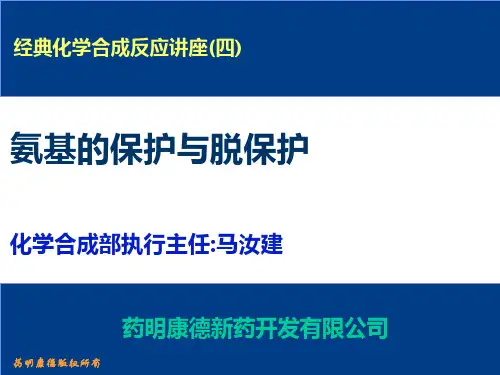
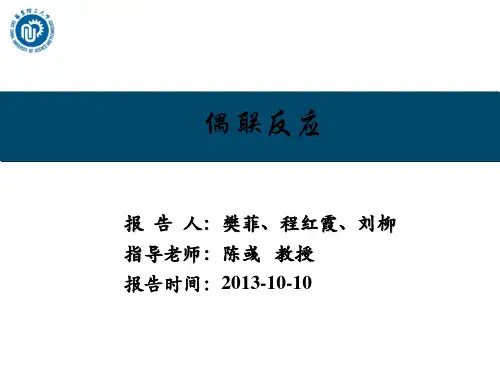
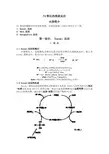
Pd催化的偶联反应内容简介Pd 催化的偶联反应有较多类型,目前用途最广泛的主要有以下三类:1. Suzuki 反应2. Heck 反应3. Sonogashira 反应第一部分: Suzuki 反应1. 前 言1.1 Suzuki反应的通式在钯催化下,有机硼化合物与有机卤素化合物进行的偶联反应,称之为Suzuki偶联反应,或Suzuki-Miyaura 偶联反应。
R1BY2R2X [Pd]R1R2+BY2 = B(OR)2, 9-BBN, B(CHCH3CH(CH3)2)X = I, Br, Cl, OSO2(C n F2n+1), n = 0,1,4R1 = aryl, alkenyl, alkylR2 = aryl, alkenyl, alkynyl, benzyl, allyl, alkyl[Pd] = Pd(PPh3)4, Pd(dppf)Cl2base = Na2CO3, NaOCH2CH3, TIOH, N(CH2CH3)3, K3PO41.2 Suzuki反应的机理Suzuki 偶联反应的催化循环过程通常认为先是Pd(0)与卤代芳烃发生氧化-加成反应生成Pd(II) 的络合物,然后与活化的硼酸发生金属转移反应生成Pd(II)的络合物,最后进行还原-消除而生成产物和Pd(0)。
1.3 Suzuki反应的特点及研究方向这类偶联反应有一些突出的优点:1.反应对水不敏感;2.可允许多种活性官能团存在;3.可以进行通常的区域和立体选择性的反应,尤其是,这类反应的无机副产物是无毒的并且易于除去,这就使得其不仅适用于实验室而且可以用于工业化生产。
其缺点是氯代物(特别是空间位阻大的氯代物)及一些杂环硼酸反应难以进行。
目前,Suzuki 偶联反应的研究主要在以下几个方向:1. 合成并筛选能够在温和的条件下高效催化卤代芳烃(特别是氯代芳烃)的配体;2. 多相催化体系的Suzuki偶联反应研究;3. 应用于Suzuki 偶联反应的新合成方法研究。

经典化学合成反应标准操作Suzuki 反应编者:刘德军、武伟药明康德新药开发有限公司化学合成部目录1 前言 (3)1.1 Suzuki反应的通式 (3)1.2 Suzuki反应的机理 (3)1.3 Suzuki反应的特点及研究方向 (4)2 有机硼试剂的合成 (4)2.1 通过金属有机试剂制备单取代芳基硼酸 (4)2.1.1 通过Grinard试剂制备单取代芳基硼酸示例 (4)2.1.2 通过有机锂试剂制备单取代芳基硼酸示例 (5)2.2 通过二硼烷频哪酯制备芳基硼酸酯 (6)2.2.1 通过二硼烷频哪酯制备芳基硼酸酯示例(一) (9)2.2.2 通过二硼烷频哪酯制备芳基硼酸酯示例(二) (10)2.2.3 通过芳基硼酸转化为芳基硼酸酯 (10)2.3 烯基硼酸酯的制备 (10)2.4 烷基硼酸酯的制备 (10)3 催化剂的制备 (11)3.1 Pd(PPh3)4的制备 (11)3.2 Pd(PPh3)2Cl2的制备 (12)3.3 Pd(dppf)Cl2的制备 (12)4Suzuki偶联的应用 (12)4.1 普通的芳卤和芳基硼酸的Suzuki偶联 (13)4.1.1 Pd(PPh3)4-Na2CO3-DME-H2O 体系Suzuki偶联反应示例 (14)4.2 大位阻芳基硼酸参与Suzuki偶联反应 (14)4.3 含敏感功能团的芳基硼酸(酯)参与Suzuki偶联反应 (15)4.3.1 芳基硼酸频哪酯和芳基卤代物的Suzuki偶联 (16)4.3.2 带着酯基底物的Suzuki偶联反应示例(一) (16)4.3.3 带着酯基底物的Suzuki偶联反应示例(二) (17)4.4 杂环芳基硼酸参与Suzuki偶联反应 (17)4.5烷基硼酸参与Suzuki偶联反应 (18)4.6烯基硼酸参与Suzuki偶联反应 (19)4.7 Triflate参与Suzuki偶联反应 (19)4.7.1芳基的三氟甲基磺酸酯与芳基硼酸偶联示例 (20)4.7.2 芳基的Triflate与芳基硼酸偶联示例 (20)4.8 芳基氯参与Suzuki偶联反应 (21)4.8.1钯催化下芳基氯参与Suzuki偶联反应示例(一) (21)4.8.2钯催化下芳基氯参与Suzuki偶联反应示例(二) (22)4.9 镍催化体系用于Suzuki偶联反应 (22)4.9.1 NiCl2(dppf)和n-BuLi催化下芳基氯参与Suzuki偶联反应示例 (22)4.10 其他方法 (23)4.10.1 直接Pd/C用于Suzuki偶联反应示例 (23)4.10.2 直接Pd(OAc)2用于Suzuki偶联反应示例 (23)1 前言1.1 Suzuki 反应的通式在钯催化下,有机硼化合物与有机卤素化合物进行偶联反应,这就提供了一类常用和有效的合成碳-碳键化合物的方法,我们称之为Suzuki 偶联反应,或Suzuki-Miyaura 偶联反应。
pd催化环丙烯醛基化的三组分偶联下载提示:该文档是本店铺精心编制而成的,希望大家下载后,能够帮助大家解决实际问题。
文档下载后可定制修改,请根据实际需要进行调整和使用,谢谢!本店铺为大家提供各种类型的实用资料,如教育随笔、日记赏析、句子摘抄、古诗大全、经典美文、话题作文、工作总结、词语解析、文案摘录、其他资料等等,想了解不同资料格式和写法,敬请关注!Download tips: This document is carefully compiled by this editor. I hope that after you download it, it can help you solve practical problems. The document can be customized and modified after downloading, please adjust and use it according to actual needs, thank you! In addition, this shop provides you with various types of practical materials, such as educational essays, diary appreciation, sentence excerpts, ancient poems, classic articles, topic composition, work summary, word parsing, copy excerpts, other materials and so on, want to know different data formats and writing methods, please pay attention!一、引言环丙烯醛基化的三组分偶联反应作为一种有效的化学合成方法,近年来备受关注。